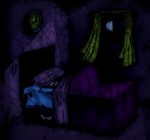Staring down the Boogieman

The only sound heard on the wooden floor is of footsteps — quickening their pace as they reach the bedroom door. The noise then becomes mute, as the small body stretches out in mid-air like a long jumper. The clearing was landed as the child’s body comes to rest on the mattress below.
He had again successfully cleared the area in front of the bed. The mysterious pair of arms would have to wait another night to plan its attack.
This is the fear that tormented Morgan Sasso, a Castleton senior, for most of his childhood. The constant worry and fear he would feel as bedtime slowly approached was no match for the adrenaline rush that manifested in his body as he jumped to his bed.
Getting out of bed required a similar effort. Sasso would jump out of bed and quickly run to the doorway before he felt safe.
“Looking back on it, the whole thing is kinda funny now,” said Sasso. “I was so afraid of what I knew wasn’t really there, but it still made me petrified.”
For freshmen Kevin McCarthy, the scariest thing was being alone at home. McCarthy and his twin brother were home alone after school until the workday was over for their parents.
“Scary stuff would always happen to us when we were by ourselves,” said McCarthy. “We were always caught in crazy situations.”
On one occasion, the McCarthy twins came home from school just like any other day. When one of the brothers went to use the phone a mysterious voice was on the other end. A sudden feeling of panic came over the two.
They then ran down the road half-a-mile in the boondocks of Vermont.
“We were hauling butt down the road,” McCarthy said, laughing in between words ready to give the punch line to his story. “We saw some guys working on the telephone wires so we stopped running. They told us if anything funky was going on with the phones not to worry.”
McCarthy said having a twin brother got rid of the fear of loneliness, but the scenarios they found their way into became stranger each time. He said it became something they began to expect.
After taking that last step off the school bus and if nothing happened to put the twins in peril before their parents came home, the day would seem too out of the ordinary.
Childhood fears are most commonly thought of as the boogieman, a pair of arms, or blood according to many Castleton students. But children eventually realize the pair of arms under the bed is really just a figment of their imagination. The
fact children, humans at that, feel fear makes it vital to survival.
“Without fear our ancestors would be eradicated with all the dangers around them,” Castleton psychology professor, Terry Bergen, said. “If we weren’t afraid of bears, they would have wiped our ancestors out.”
Fears are necessary for human survival, protecting people from things that could be very harmful according to Bergen. But somewhere in the mix people develop strange phobias because of irrational fears. The age of seven is the age of reason, according to Bergen. At this age kids commonly overcome the arms under the bed or need the night light to brave the darkness.
Bergen said phobias are maladaptive fear. A fear enhances life and allows people to live happily and successfully. Phobias reduce a person’s freedom, restricting them from life’s luxuries. People are hardwired for phobic reactions.
Castleton Psychology Chair, John Klein spoke about a more specific phobia adopted by children.
“Let’s say you go to school and there is a school shooting,” Klein said. “You would have a phobic reaction. You might see a school psychologist.”
Although there is no particular way to overcome a fear or phobia, there are steps one can take to feel safer. Smaller steps towards resolution are the best way to overcome a phobias according to Klein.
“The psychologist would have you do oriented stuff, like walking by the bus stop, walking up to the school door. That would reduce the phobic reaction to whatever is causing it,” Klein said.
Klein also explained how dark places make children so afraid because the lack of control they feel. The mystery hidden in the darkness also plays a mental factor. The one thing distinguishing people from other organisms is that humans have a frontal cortex he said. This ability for people to think at a higher level, also allows them to create very odd fears.
The cover of the Stephen King movie “IT” haunted the bedtime of Castleton freshmen, Brittany Baron. Pennywise, the menacing clown would stare down off the VHS box and would be engraved in Baron’s head until bedtime.
By the time the lights turned off the self-torment began. The mental battle would begin just before slipping off into dreamland.
“I was like seven,” said Baron, remembering a nightmare with King’s freakish clown. “IT was patrolling the entire neighborhood in a mote, he was rowing around in a boat. He was growling at us. His teeth were scary!




